Multispectral Fusion Approach for Traffic Target Detection in Bad Weather
Abstract
1. Introduction
2. Related Works
2.1. Object Detection
2.2. Computer Vision for Traffic Surveillance Systems
3. Methods
3.1. Convolutional Base and RPN
3.2. Object Detector Model
4. Procedure and Results
4.1. Dataset and Data Augmentation
4.2. Implementation Details
4.3. Experimental Results
5. Discussion
Author Contributions
Funding
Acknowledgments
Conflicts of Interest
Appendix A
| Transformation Type | Affine Matrix | Coordinate Transform | Example |
|---|---|---|---|
| Identify | 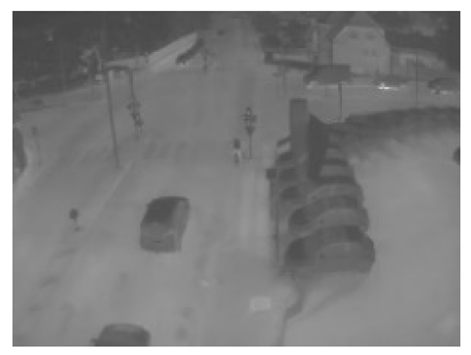 | ||
| Scaling | 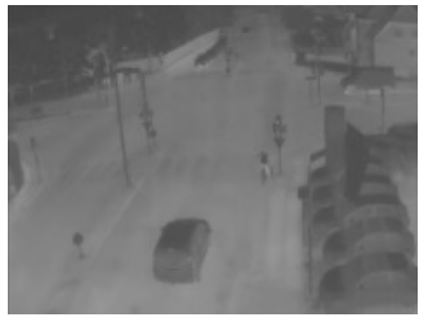 | ||
| Translation |  | ||
| Rotation | 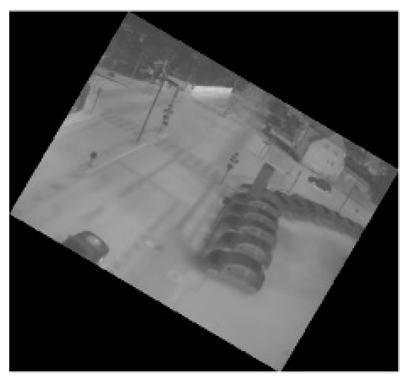 | ||
| Shear (vertical) | 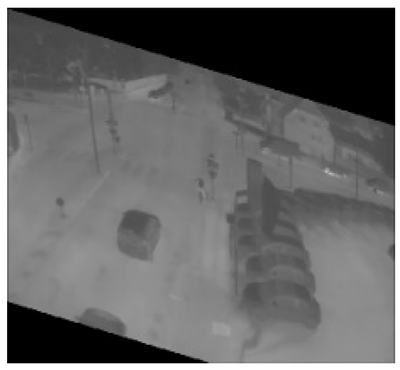 | ||
| Shear (horizontal) | 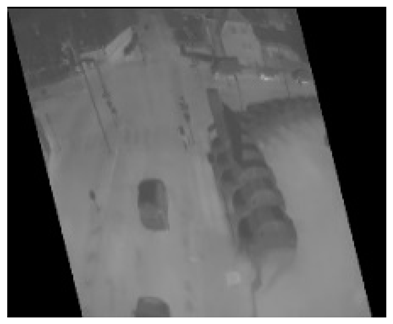 |
References
- Zhang, B.; Zhou, Y.; Pan, H. Vehicle Classification with Confidence by Classified Vector Quantization. IEEE Intell. Transp. Syst. Mag. 2013, 5, 8–20. [Google Scholar] [CrossRef]
- Park, S.H.; Jung, K.; Hea, J.K.; Kim, H.J. Vision-Based Traffic Surveillance System on the Internet. In Proceedings of the Third International Conference on Computational Intelligence and Multimedia Applications, New Delhi, India, 23–26 September 1999. [Google Scholar]
- Tang, Y.; Zhang, C.; Gu, R.; Li, P.; Yang, B. Vehicle Detection and Recognition for Intelligent Traffic Surveillance System. Multimed. Tools Appl. 2017, 76, 5817–5832. [Google Scholar] [CrossRef]
- Kumar, T.; Kushwaha, D.S. Traffic Surveillance and Speed Limit Violation Detection System. J. Intell. Fuzzy Syst. 2017, 32, 3761–3773. [Google Scholar] [CrossRef]
- Hsieh, J.W.; Yu, S.H.; Chen, Y.S.; Hu, W.F. An Automatic Traffic Surveillance System for Vehicle Tracking and Classification. Trans. Intell. Transp. Syst. 2006, 7, 175–187. [Google Scholar] [CrossRef]
- Mao, T.; Zhang, W.; He, H.; Lin, Y.; Kale, V.; Stein, A.; Kostic, Z. Aic2018 Report: Traffic Surveillance Research. In Proceedings of the 2018 IEEE/CVF Conference on Computer Vision and Pattern Recognition Workshops, Salt Lake City, UT, USA, 18–22 June 2018. [Google Scholar]
- Bahnsen, C.H.; Moeslund, T.B. Rain Removal in Traffic Surveillance:Does It Matter? IEEE Trans. Intell. Transp. Syst. 2018, 20, 2802–2819. [Google Scholar] [CrossRef]
- Ma, J.; Ma, Y.; Li, C. Infrared and Visible Image Fusion Methods and Applications: A Survey. Inf. Fusion 2019, 45, 153–178. [Google Scholar] [CrossRef]
- Viola, P.; Jones, M. Rapid Object Detection Using a Boosted Cascade. In Proceedings of the CVPR 2001, Kauai, HI, USA, USA, 8–14 December 2001. [Google Scholar]
- Sermanet, P.; Eigen, D.; Zhang, X.; Mathieu, M.; Fergus, R.; LeCun, Y. Overfeat: Integrated Recognition, Localization and Detection. In Proceedings of the ICLR 2014, Banff, AB, Canada, 14–16 April 2014. [Google Scholar]
- Girshick, R.; Donahue, J.; Darrell, T.; Malik, J. Rich Feature Hierarchies for Accurate Object Detection and Semantic Segmentation. In Proceedings of the CVPR 2014, Columbus, OH, USA, 23–28 June 2014. [Google Scholar]
- Girshick, R. Fast R-CNN. In Proceedings of the ICCV 2015, Santiago, Chile, 7–13 December 2015. [Google Scholar]
- Ren, S.; He, K.; Girshick, R.; Sun, J. Faster R-CNN: Towards Real-Time Object Detection with Region Proposal Networks. In Proceedings of the NIPS 2015, Montreal, QC, Canada, 7–12 December 2015; pp. 1440–1448. [Google Scholar]
- Lin, T.Y.; Dollár, P.; Girshick, R.; He, K.; Hariharan, B.; Belongie, S. Feature Pyramid Networks for Object Detection. In Proceedings of the CVPR 2017, Honolulu, Hawaii, 21–26 July 2017. [Google Scholar]
- Liu, W.; Anguelov, D.; Erhan, D.; Szegedy, C.; Reed, S.; Fu, C.Y.; Berg, A.C. SSD: Single Shot MultiBox Detector; Springer: Cham, Switzerland, 2016. [Google Scholar]
- Fu, C.Y.; Liu, W.; Ranga, A.; Tyagi, A.; Berg, A.C. Dssd: Deconvolutional Single Shot Detector. arXiv 2016, arXiv:1701.06659. [Google Scholar]
- Redmon, J.; Divvala, S.; Girshick, R.; Farhadi, A. You Only Look Once: Unified, Real-Time Object Detection. In Proceedings of the CVPR 2016, Las Vegas, NV, USA, 27–30 June 2016; p. 1. [Google Scholar]
- Pirsiavash, H.; Ramanan, D.; Fowlkes, C.C. Globally-Optimal Greedy Algorithms for Tracking a Variable Number. In Proceedings of the Computer Vision and Pattern Recognition (CVPR), Colorado Springs, CO, USA, 21–23 June 2011. [Google Scholar]
- Yang, B.; Huang, C.; Nevatia, R. Learning Affinities and Dependencies for Multi-Target Tracking Using Acrf Model. In Proceedings of the Computer Vision and Pattern Recognition (CVPR), Colorado Springs, CO, USA, 21–23 June 2011. [Google Scholar]
- Choi, W. Near-Online Multi-Target Tracking with Aggregated Local Flow Descriptor. In Proceedings of the IEEE International Conference on Computer Vision, Santiago, Chile, 11–18 December 2015. [Google Scholar]
- Wojke, N.; Bewley, A.; Paulus, D. Simple Online and Realtime Tracking with a Deep Association Metric. In Proceedings of the 2017 IEEE International Conference on Image Processing (ICIP), Beijing, China, 17–20 September 2017. [Google Scholar]
- Bebis, G.; Gyaourova, A.; Singh, S.; Pavlidis, I. Face Recognition by Fusing Thermal Infrared and Visible Imagery. Image Vis. Comput. 2006, 24, 727–742. [Google Scholar] [CrossRef]
- Kumar, P.; Mittal, A.; Kumar, P. Fusion of Thermal Infrared and Visible Spectrum Video for Robust Surveillance. In Computer Vision, Graphics and Image Processing; Springer: Berlin/Heidelberg, Germany, 2006. [Google Scholar]
- Wagner, J.; Fischer, V.; Herman, M.; Behnke, S. Multispectral Pedestrian Detection Using Deep Fusion Convolutional Neural Networks. In Proceedings of the European Symposium on Artificial Neural Networks, Bruges, Belgium, 27–29 April 2016. [Google Scholar]
- Liu, J.; Zhang, S.; Wang, S.; Metaxas, D.N. Multispectral Deep Neural Networks for Pedestrian Detection. In Proceedings of the British Machine Vision Conference, York, UK, 19–22 September 2016. [Google Scholar]
- Szegedy, C.; Ioffe, S.; Vanhoucke, V.; Alemi, A. Inception-V4, Inception-Resnet and the Impact of Residual Connections on Learning. In Proceedings of the National Conference on Artificial Intelligence, Phoenix, AZ, USA, 12–17 February 2016. [Google Scholar]
- Bell, S.; Lawrence Zitnick, C.; Bala, K.; Girshick, R. Inside-Outside Net:Detecting Objects in Context with Skip Pooling and Recurrent Neural Networks. In Proceedings of the IEEE Conference on Computer Vision and Pattern Recognition, Las Vegas, NV, USA, 27–30 June 2016. [Google Scholar]
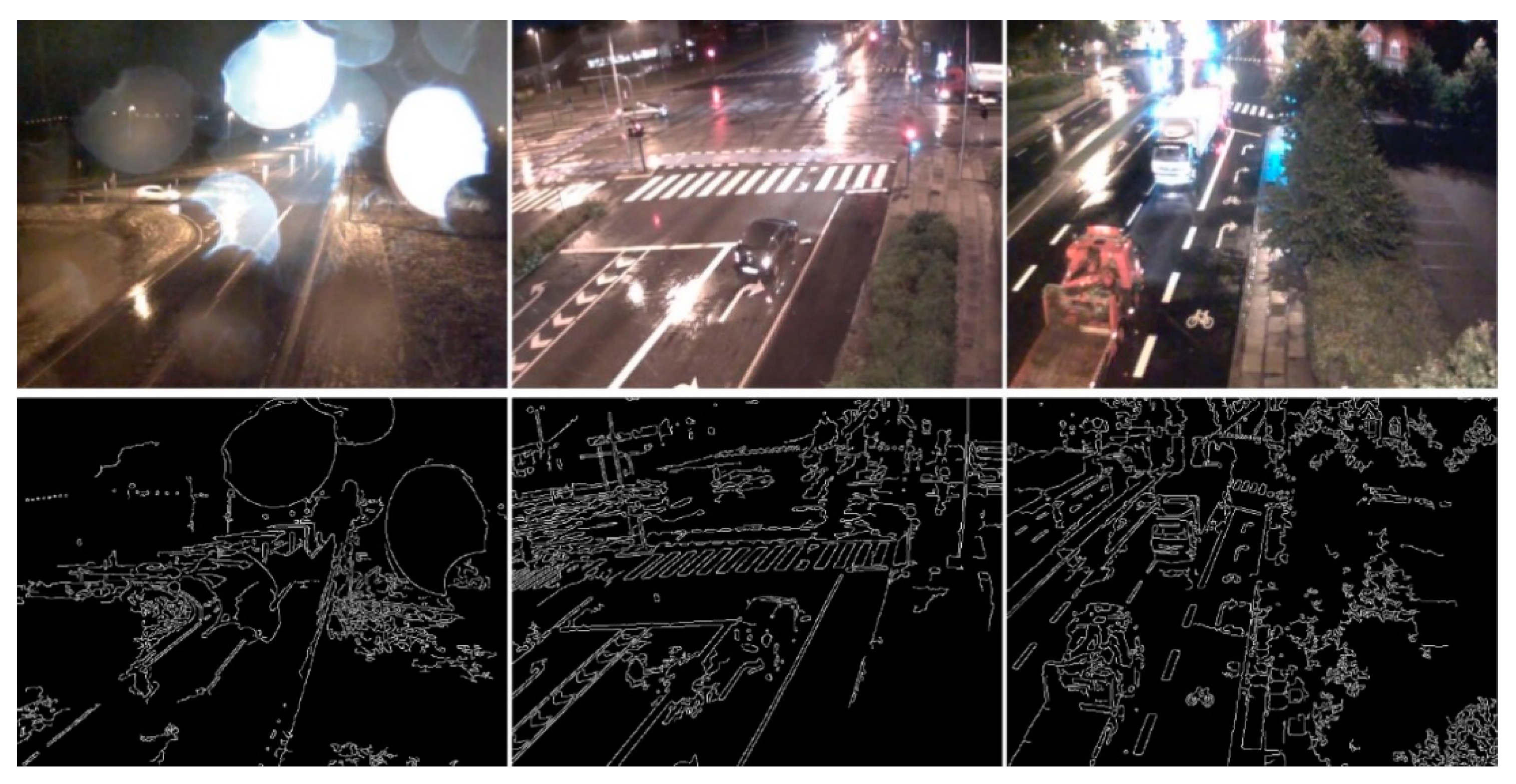


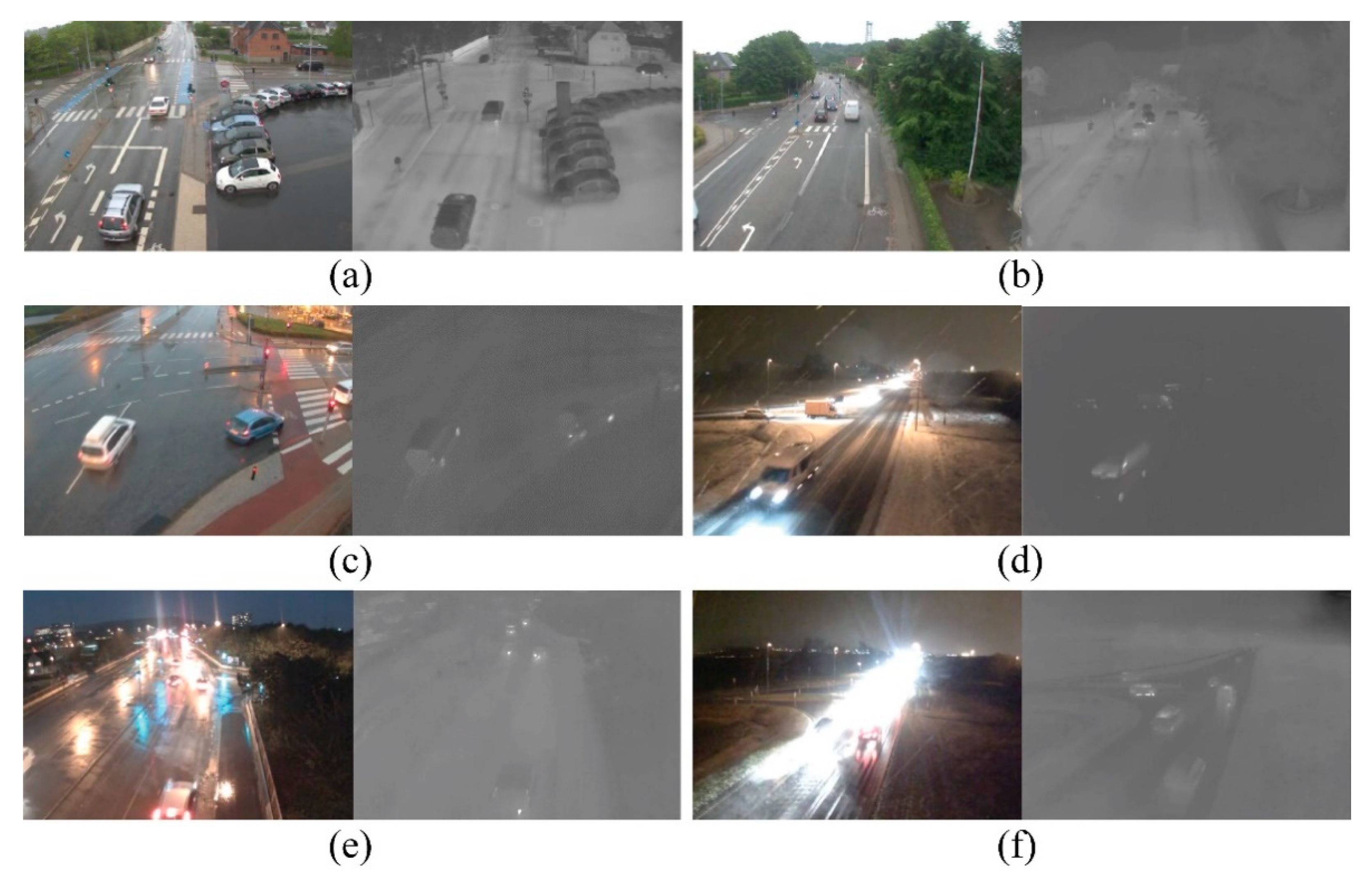

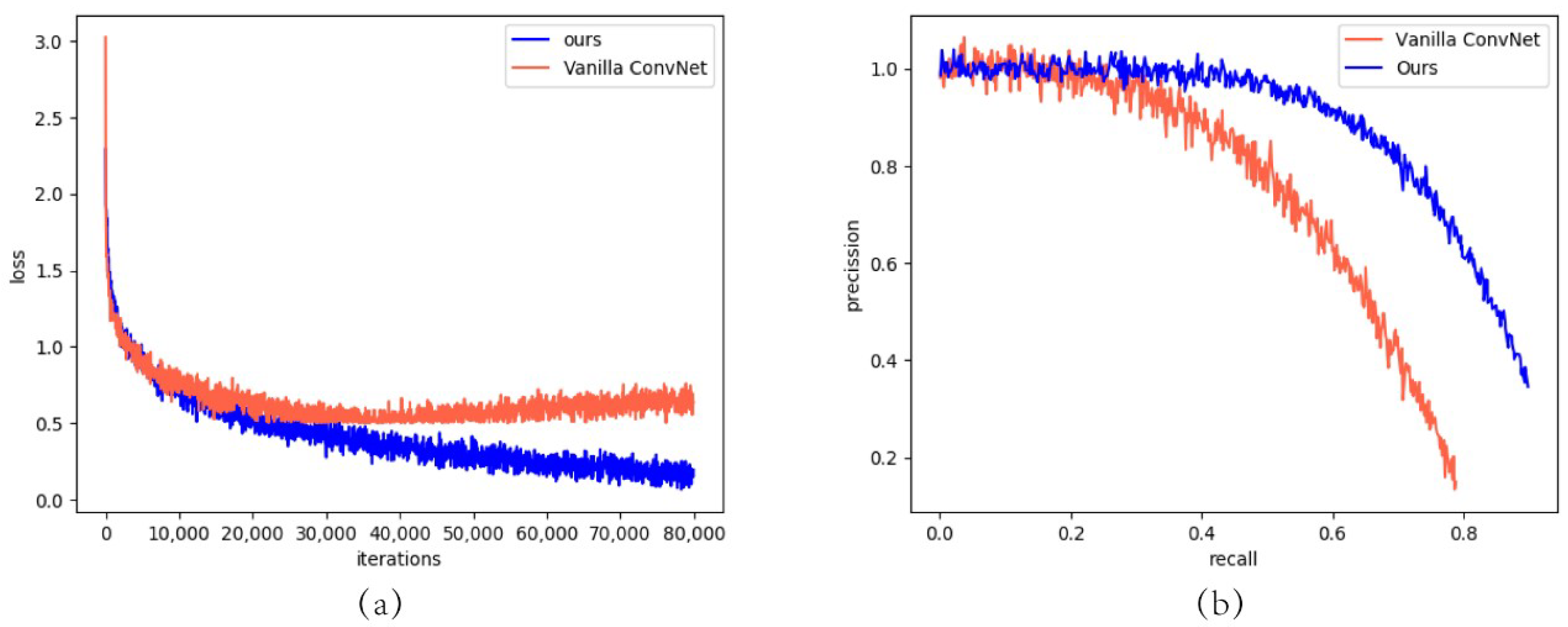
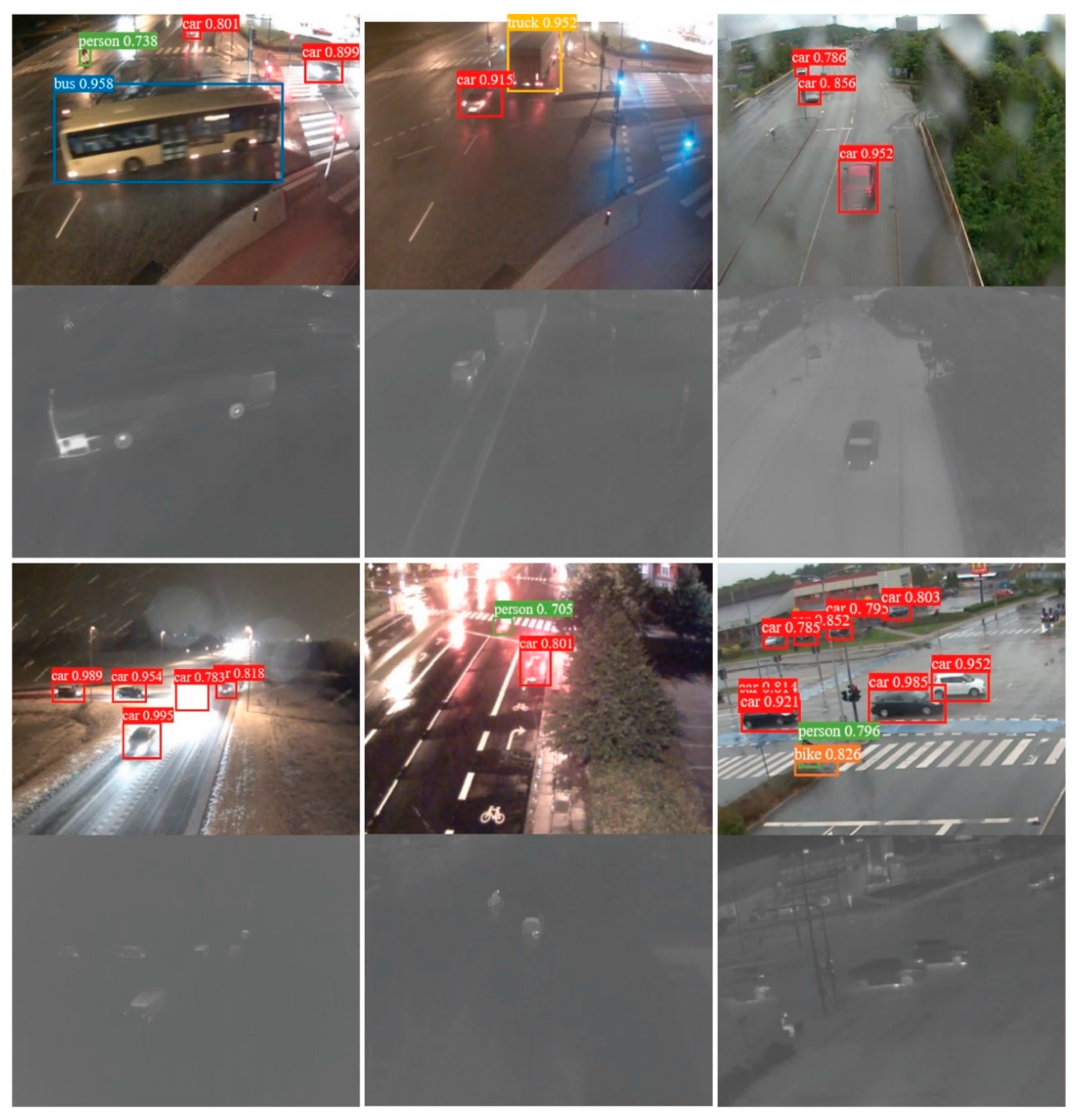
| Layer Name | Base Network 1 | Base Network 2 |
|---|---|---|
| Conv_1 | 7 × 7, 64, Stride 2 | |
| 3 × 3 max pool, Stride 2 | ||
| Conv_2 | ||
| Conv_3 | ||
| Conv_4 | ||
| Conv_5 | ||
| Good Weather | Bad Weather | ||||||
|---|---|---|---|---|---|---|---|
| Sunny Day | Clear Night | Rainy Day | Rainy Night | Reflection | Blur | ||
| mAP | Ours | 79.8 | 70.3 | 69.2 | 64.9 | 65.4 | 61.1 |
| Vanilla ConvNet | 75.3 | 60.5 | 66.4 | 54.2 | 43.3 | 39.9 | |
| Average mAP | Ours | 75.05 | 65.15 | ||||
| Vanilla ConvNet | 67.9 | 50.95 | |||||
Publisher’s Note: MDPI stays neutral with regard to jurisdictional claims in published maps and institutional affiliations. |
© 2020 by the authors. Licensee MDPI, Basel, Switzerland. This article is an open access article distributed under the terms and conditions of the Creative Commons Attribution (CC BY) license (http://creativecommons.org/licenses/by/4.0/).
Share and Cite
Han, Y.; Hu, D. Multispectral Fusion Approach for Traffic Target Detection in Bad Weather. Algorithms 2020, 13, 271. https://doi.org/10.3390/a13110271
Han Y, Hu D. Multispectral Fusion Approach for Traffic Target Detection in Bad Weather. Algorithms. 2020; 13(11):271. https://doi.org/10.3390/a13110271
Chicago/Turabian StyleHan, Yajing, and Dean Hu. 2020. "Multispectral Fusion Approach for Traffic Target Detection in Bad Weather" Algorithms 13, no. 11: 271. https://doi.org/10.3390/a13110271
APA StyleHan, Y., & Hu, D. (2020). Multispectral Fusion Approach for Traffic Target Detection in Bad Weather. Algorithms, 13(11), 271. https://doi.org/10.3390/a13110271





